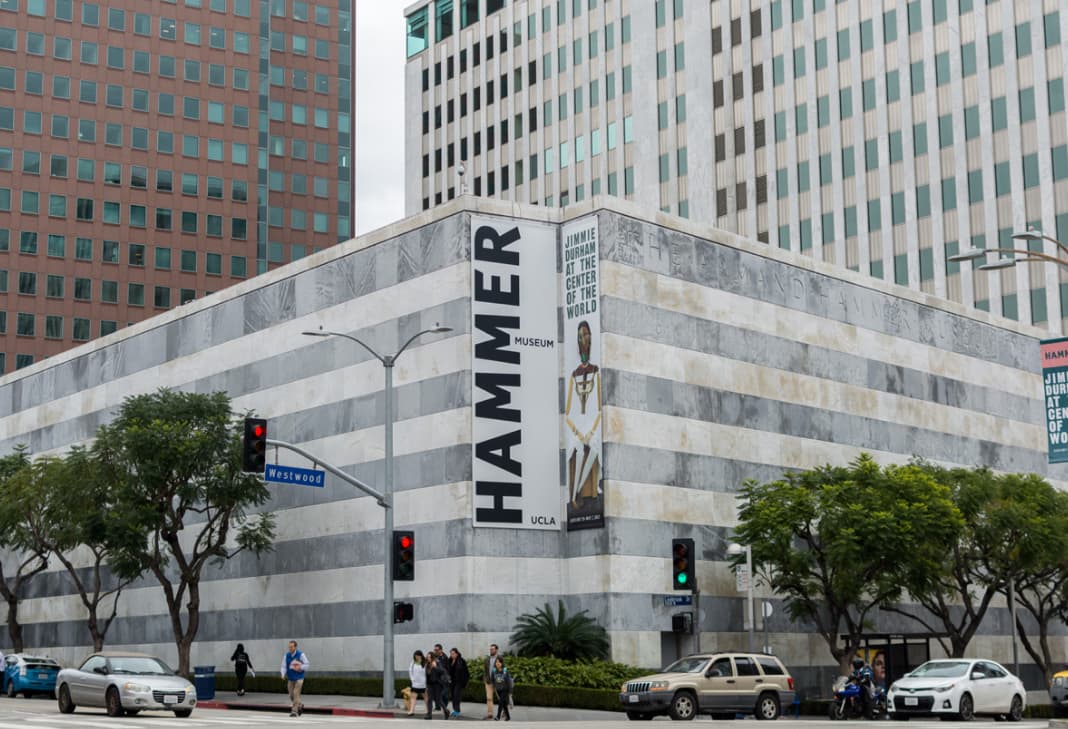- Theme: The Hammer Museum, affiliated with UCLA, showcases contemporary and historical artworks across all media, along with a full roster of free public programs like film screenings, performances, and discussions on social issues. Its collections include the Armand Hammer Collection of European and American art, the Grunwald Center Collection with over 45,000 works on paper, and the Hammer Contemporary Collection focused on international contemporary art since 1960;
- Opening Hours: The museum is open Tuesday through Thursday and on the weekends from 11 AM to 6 PM, and on Friday from 11 AM to 8 PM. It is closed on Mondays, July 4, Thanksgiving, Christmas, and New Year’s Day;
- Official Site: https://hammer.ucla.edu;
- Phone Number: (310) 443-7000;
- Email: For general inquiries, you can contact [email protected];
- Ticket Price: Admission to the Hammer Museum is free for all visitors, courtesy of its supporters.
The Hammer Museum: A Beacon of Art and Ideas
The inception of the Hammer Museum was marked by Dr. Armand Hammer’s ambition to create a space where art meets the public in meaningful dialogue. This vision laid the foundation for a museum that not only houses art but also invites critical conversations about our world.
Transformative Years
The transition into a partnership with UCLA marked a significant turning point for the museum, expanding its reach and integrating it more deeply into the cultural and academic life of Los Angeles. This period of transformation was crucial in shaping the museum’s contemporary identity.
A Cultural Hub for All
Today, the museum stands as a vibrant center for the arts, known for its diverse and engaging exhibitions. Its commitment to free admission underlines a dedication to accessibility, making it a welcoming space for all visitors to explore the transformative power of art. Beyond being a mere repository of objects, the museum actively engages with the community, hosting a variety of public programs including film screenings, performances, and discussions that tackle contemporary social issues. These initiatives not only enhance the visitor experience but also foster a deeper understanding and appreciation of the arts within a broader societal context. By prioritizing accessibility, the Hammer Museum ensures that art and culture are within reach of diverse audiences, reinforcing the idea that art is a crucial part of public life.
Dynamic Programming and Collections
The Hammer Museum’s eclectic programming and impressive collections offer a wide-ranging exploration of visual arts. From historical masterpieces to contemporary works that provoke thought and discussion, the museum fosters an environment where art and societal issues intersect. The museum’s exhibitions often explore themes relevant to current events and social justice, inviting visitors to reflect on the role of art in shaping and reflecting societal values. Additionally, the museum’s commitment to showcasing emerging and underrepresented artists provides a platform for voices that are often marginalized in the broader art world. This approach not only diversifies the museum’s offerings but also challenges visitors to engage with new perspectives and ideas, furthering the museum’s mission as a space for exploration and discovery.
Leadership and Vision
The strategic direction set by the museum’s leadership has been pivotal in its evolution. Through periods of expansion and renewal, the museum has remained committed to its foundational vision of a space where art and public discourse thrive. The leadership’s innovative approach to programming and community engagement has positioned the museum as a forward-thinking institution that responds to and reflects the complexities of contemporary society. This vision extends beyond the physical space of the museum, embracing digital platforms to reach wider audiences and foster global conversations. The museum’s leaders have also emphasized sustainability and inclusivity in their strategic planning, ensuring that the museum not only serves as a cultural landmark but also as a responsible and ethical steward of cultural heritage. Through their guidance, the Hammer Museum continues to evolve, embracing challenges and opportunities with a clear vision for the future of art and public engagement.
Architectural Elegance and Academic Integration
The museum’s architecture and its integration with UCLA enrich its role as an educational resource, offering a unique blend of public engagement and academic collaboration. This relationship enhances the museum’s capacity to serve as a bridge between scholarly research and the broader community. The synergy between the museum and the university fosters a dynamic environment where art and academia intersect, leading to a host of benefits:
- Interdisciplinary Learning: The museum’s proximity and affiliation with UCLA enable the integration of art with various academic disciplines, fostering interdisciplinary learning opportunities for students and faculty alike;
- Research Opportunities: Scholars and students have access to the museum’s vast collections for research, allowing for in-depth studies in art history, cultural studies, and beyond;
- Public Lectures and Seminars: Collaborations often result in a rich program of lectures, seminars, and workshops, featuring experts from diverse fields, enhancing the educational experience for both the university community and the public;
- Student Engagement: The museum offers internships, fellowships, and volunteer opportunities, providing hands-on experience in the museum field and arts administration to UCLA students;
- Community Outreach: Joint programs between the museum and UCLA extend educational outreach to local schools and communities, promoting art education and appreciation among a broader audience;
- Innovative Exhibitions: The collaboration often results in innovative exhibitions that draw on the university’s academic resources, including contributions from faculty and students, leading to fresh perspectives and new insights into the artworks on display.
Conclusion
As a site of continuous evolution, the Hammer Museum exemplifies how art institutions can play a crucial role in reflecting and shaping societal discourse. It remains a vital cultural asset in Los Angeles and a model for museums worldwide, embodying a commitment to inclusivity, dialogue, and the power of art to inspire change.
